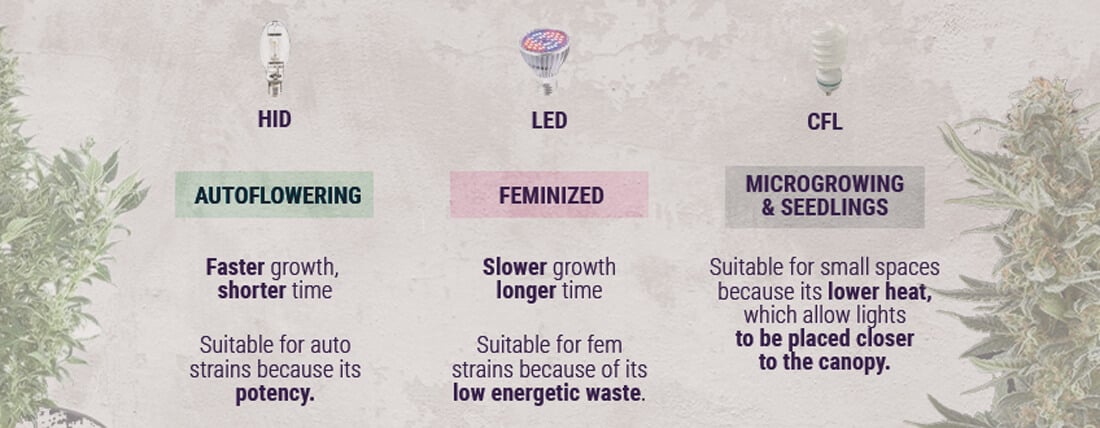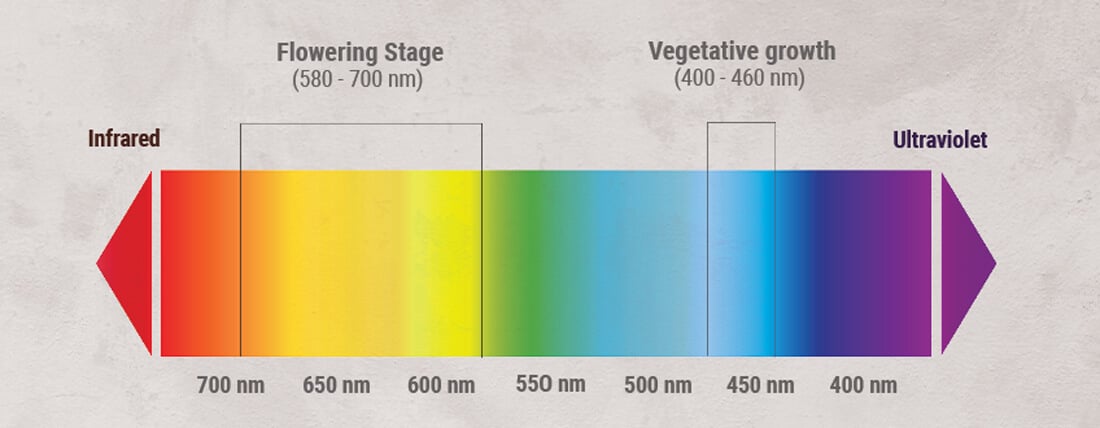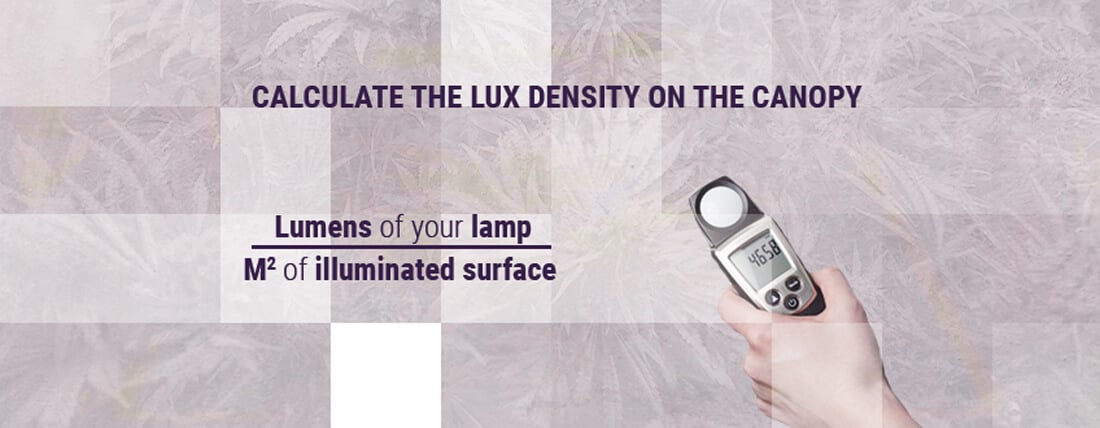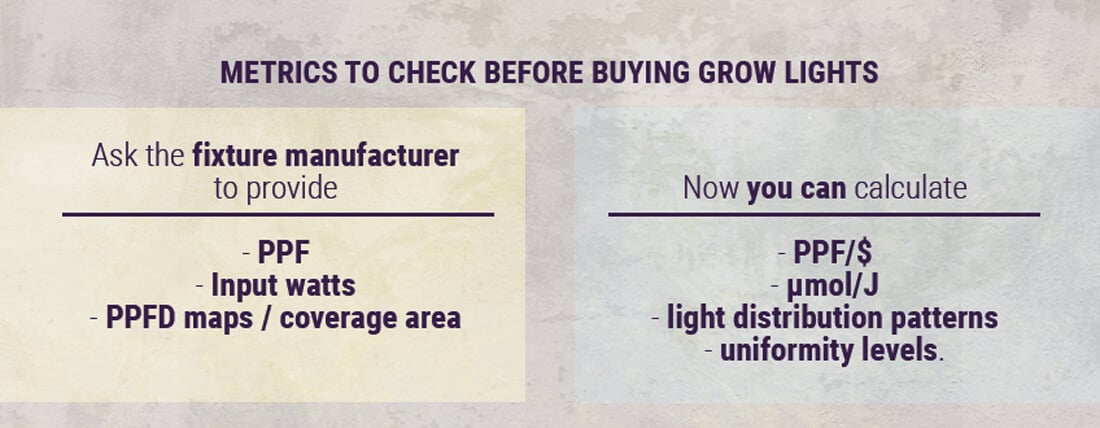Marijuana growing tips: How to set up indoor plant lights
Too much light can damage your cannabis plants, just as too little light. Learn all you need to know about cannabis-related light and how to set up growth lights correctly for large amounts of indoor harvesting.
Learn to evaluate and position your cannabis plant lights for maximum results.
content:
1, 3 of the most common types of modern plant growth lamps
2, spectra, standard values and tluminescum
3, Par and ppfd in watt calculations
4. Sun, light bulb and proper photon pressure
5. How much light does your plantation need?
6, per square meter wattage rules: How many plants can you plant?
7, Hid (mh, hps): the rule of the correct distance
8, Led: the correct distance rules
3 of the most common types of modern plant lamps
Contemporary indoor cannabis cultivation typically involves at least one of three artificial light sources:HID,CFL, and LED. Typically, growers use a combination of growth lamps. Of course, there are other, older lighting technologies, but they are almost all "Betamax" lights. This blog highlights the most common lighting used by cannabis growers in the 21st century. Without relying on pseudoscientific statistics, we focus on practical growth room recommendations.
Hid or high-intensity discharge lamps have been the growth lights of choice for a wide range of indoor growers, from beginners to professional growers, since at least the early 1990s. Over the years, lights have become more efficient, ballasts have become digital, and reflectors have become larger and better. HID-enabled growers believe that trout is the only important lighting output statistic.
Of course, CMH or ceramic metal halide lamps have emerged, and the 315W CMH bulbs are impressive, but this is a fairly expensive upgrade for standard MH or metal halide lamps. In addition, the 315W CMH does not perform as well as high-end dual-spectral/agricultural 600W HPS or high-pressure sodium lamps. Similarly, the CFL shows some promise, but always runs farther than a proven and trusted HID.
LED or light-emitting diodes are a breakthrough technology that promises to end HID's dominance of cannabis cultivation. The latest generation of LED systems is now capable of producing higher quality cannabis than regular HID devices. PAR or photosynthesis effective radiation is considered the most important indicator by LED enthusiasts.
It is best not to become too addicted to new light measurements and modified spectra. Keep things simple. Think of light in watts and electricity bills. Then there's the question, "What's the power consumption?" The second is, "How much heat does the lamp generate and how much light does it emit?"
Old style: HID lamp
In plain decent Stoner terminology, HID gets some new giddy, but the core principle of cultivating marijuana with this artificial light remains the same. MH is used for nutritional growth and HPS is used for flowering. Although, dual-spectral HPS lamps are a popular alternative and may even be more suitable for self-flowering varieties.
400W and 600W bulbs are best suited for indoor cannabis cultivation. The lamp needs to be hung horizontally. The optimum light height or OLH is between 30-50 cm above the plant crown. This means carefully securing the reflector to the ceiling or roof of the planting tent using a simple roll hanger or rope ratchet.
It is best to use fixtures that can be easily adjusted and repositioned as plants mature and grow taller. However, seedlings and seedlings may find 600W MH too strong and a distance of more than 60 cm may be more appropriate.
Don't use light rail unless you have an engineering certificate. Fixed lamps installed in clean, open reflectors that do not shake the horizontal bulb are professional standard cultivation. Ideally, use a large reflector, or squeeze as large as possible into the growth space and make extensive use of the entire area.
Glass filters, lamps and air cooling lamps are expensive. As a result, cold tubes are actually only suitable for closets because they have the worst reflectivity of any reflector on the market. Adding more lights and more fans means higher electricity bills.

Lighting and growth space
In general, 400-600 watts of light per square meter is sufficient for home-grown programs. Commercial growers may push it to 1000W plus for maximum yield. Putting as many lights as possible on the plantation is not a shortcut to a good harvest. More HID lights mean more light, but also more heat. These babies are very hot. The 250W lamp is only suitable for micro growers.
The only advantage the 250W lamp offers is that the top of the plant can be close to the bulb by 20 cm. The heat output is well below 600W, but the light does not penetrate that far. Limited light will reach lower branches of higher plants.
Just add an additional 600W HPS to dramatically increase the planting temperature. Investing in upgrading plantations is often a lower-cost, more efficient solution. Either cover the walls with polyester film, upgrade from a magnetic ballast to a dimmable digital ballast, or use LEDs all the time.
How many plants are there?
The answer is that growers like more or less. You can pack 16 cannabis plants in 11-litre square containers and place them in 1 square metre of planting space in SOG. Alternatively, growers can use the ScrOG method to fill the same space with a large plant. Either way, the yield will be comparable. Again, it all depends on how you use light and growth areas.
Supplement CFL
CFL or compact fluorescent lamps are very effective as an alternative to MH bulbs in the cold white spectrum. A 250W CFL can provide comparison results with a 400W gold halogen lamp. This is achieved by hanging the CFL 10 cm above the plant crown. CFL runs coolly and can be very close to plants without burning leaves. In addition, CFL lamps only slightly increase the planting temperature. This makes CFL ideal for seedlings, insertion and use during nutrient growth. CFL lamps are sometimes the only option for micro growers.
Unfortunately, the CFL has neither impressive luminescies nor PAR output numbers. To make matters worse, CFL lamps are not very effective for flowering marijuana. Cannabis plants need much stronger light during flowering than the CFL can provide. During the flowering phase, CFL lamps are expected to yield light yields and loose buds.
Next-generation LEDs
The latest LED systems are finally on par with traditional HID lighting systems. The current situation is similar to that of flat-screen TVs when they first came out at the turn of the century. The benefits and benefits are obvious. However, the limiting factor is the high prices of leading manufacturers.
High-performance LED kits with 350-400W power and better performance than 600W MH and HPS configurations with full spectral arrays are not cheap. There are some models that can really do it all. In the long run, the best systems work coolly and very economically. Hanging distances vary widely, so buyers should be careful and make sure to check the manufacturer's instructions.

Below, we delve into the science behind light output so you can evaluate the ideal wattage and location of cannabis growth lamps. We'll cover terms such as photons, lumens, and PAR, as well as the main types of growth lamps and their differences.
Spectroscopy, PAR, and trone
Light consists of photons, tiny particles that inevitably travel at the speed of light. Photons in a beam vibrate at different frequencies and wavelengths. Humans can see photon radiation with a wavelength range of 380-680nm, while plants are sensitive to light from 200-800nm. Not all wavelengths in the spectrum have the same effect on photosynthesis. The substances that most activate the biochemical processes of plants are called PAR (photosynthesis active radiation) and have a spectral range of 400-700nm.
Light can be measured by measurements of the sensitivity of the human eye to color, or by the amount of radiation associated with the energy emitted by the beam. Luminescum and lux are commonly used units of luminosity, referring to light perceived by the human eye.
However, photometric measurements do not indicate how much light the lamp sends to plants for photosynthesis because they do not include PAR variables. Nevertheless, luminescious and lux can provide initial indication of the output of specific bulbs, and we can compare different products by measuring their luminosity efficiency and luminosity: Watt ratio, regardless of the final difference in spectral output at different wavelengths.
Lux and luminescious are effective at measuring MH, HPS, CFL, and T5 lamps, but the efficiency of LED lamps cannot be accurately measured when growing cannabis.
PAR and PPFD in watt calculations
Broadly speaking, the minimum broad-spectrum amount of light required for cannabis plants is approximately 9,000 luminescent per square metre, with an optimal amount of more than 20,000 luminescents per square metre. However, the growth and flowering of exuberant indoor plants depends on the light threshold reached at the specific wavelength at which photosynthesis is triggered. This is why LED plant growth lamps use radiation measurement systems to measure the number of photons emitted at the PAR color frequency we mentioned earlier.
The most widely used radiation measurement in gardening is PPFD(photoreconferencing photon flux density), which measures the flow of PAR photon micromolars per square meter (μmol/m2/s). Assuming that the PPFD of the growth lamp is provided, we can calculate its radiation efficiency and compare different lighting systems using the PPFD:watt ratio.

Sun, light bulb and proper light pressure
The midsummer midday sun reaches Earth at a speed of about 45 degrees latitude with photosynthesis power of 1,200-2,000 PPFD. However, cannabis seedlings, clones and matriarchs are satisfied with PPFD of only 200-400μmol/m2/s. Hemp plants in the nutritional stage require 400-600μmol/m2/s,and flowering plants typically require 600-1500μmol/m PPFD of 2/s and atmospheric CO2 levels. One study found that at temperatures of 25-30 degrees C, the highest PPFD of cannabis was 1500-2000μmol/m2/s,increasing naturalcarbon dioxide to 750 ppm.
Even if cannabis is a demanding plant, irradiation beyond the limit threshold for each species, stage of life or environmental conditions does not necessarily increase yields. Conversely, too much photon pressure can damage leaves and flowers. In other words, when cannabis plants receive 20-30 moles of PAR light per day, flower yields increase, then level between 30-40 moles, and decrease over 40 moles.
How much light does your growth room need?
To establish the correct amount of light for your crop, you need to multiply the length of your plantation by its width to get the growth surface, and then multiply the resulting number by the PPFD level you want.
If your planting box is 250 cm long and 80 cm wide, your planting space will be 2.50m × 0.80m . If your goal is about 2 square meters of flowering plant crowns and you want to experiment with 500μmol PPFD levels, you only need 1,000μmol/m2/s. The result should then be divided by the PPFD per watt of light to determine the required wattage.
Wattage rule per square meter: How many plants can you plant?
LED systems produce more PAR than MH, HPS, and other types of lights. Nevertheless, your plant needs about the same wattage per square meter to achieve a harvest similar to that of a conventional HID bulb. Also consider that LED light systems are often advertised as more powerful than actual power consumption, but that doesn't mean that a 400W LED can cover the same area as a 1,000W HPS bulb. Here are some general charts of the power required to grow exuberant cannabis plants using different lighting systems. In the early stages of nutrition, they will require about half the power.
For reference,HPS lamps can roughly cover the following canopy areas:
|
400W ≈ 1–1.5m² ≈ 4 Plants
|
|
600W ≈ 1.3–2m² ≈ 8 株
|
|
1000W ≈ 1.8–3m² ≈ 10 plants
|
Led lights can approximately cover the following canopy areas:
|
200W ≈ 0.8m² ≈ 2 株
|
|
280W ≈ 1m² ≈ 4 株
|
|
350W ≈ 1.5m² ≈ 6-8 株
|
To find out how much light intensity you provide to plants, you can purchase a luxometer and measure the light intensity at different points in the canopy. Alternatively, you can perform theoretical calculations that take into account the luminescence emitted by the lamps associated with the growth surface. To calculate the lux pressure on the canopy, simply divide the luminescence of the lamp by the square meter of the surface being irradiated. If you place a lamp that produces 100,000lm 1m from the top of the plant, it illuminates the 1m2 area with a strength of 100,000lx (100,000lm ÷ 1m s 100,000lx). If the lamp distance is only 0.5m, it will receive 100,000lm ÷ 0.5m s 200,000lx.
Unfortunately, the coefficient of reduced luminous intensity is equal to the square of the distance from the illuminated object, so placing the same lamp at two meters increases its beam width, covering 4 square meters, but only 25,000lx. Therefore, you need four lights to reach the assumed 100,000lx target throughout the planting area.

HID (MH, HPS): Rules for the correct distance
HID bulbs are available in metal halide (MH) versions, cold light is suitable for plant growth stages, and high-pressure sodium (HPS) versions have a wider spectrum for flowering. These lights will heat up and require a proper cooling and exhaust system. Over time, they emit less light, so new bulbs should go further than older bulbs, and you should consider replacing them in a few years.
The appropriate distance between the MH and HPS bulbs depends primarily on the wattage. Always start with the light at the top of the range and gradually lower it. Assuming that the ventilation in the plantation is correct, with a smaller 250W bulb, you can start at a distance of 35 cm and gradually descend towards the canopy until you are 25 cm away from the buds at the end of the flowering phase. With a 600W bulb, you may start at 50 cm and drop to 30 cm, or if you choose a 1000W lamp, it is best to set aside at least 80 cm.
It is common practice to point your hands toward the light directly above the top of the plant, and if you feel comfortable, so will your plant. But don't believe too much in the general rules. Always check your plant for any signs of overheating or excessive photon pressure.
How high should you hang MH and HPS plant lights?
Popular, widely used and arguably the best option to increase yields, many growers are committed to using their MH or HPS growth lamps.
Although MH and HPS are suitable for different stages of the growth cycle, you can usually hang them at close proximity to plants. Both lamps work best when they are close to the crop, but if this is the first time you've tested them, it's good.
Whether you're a novice grower or changing things, we recommend starting with the upper limit of the lamp range. In this way, you can gradually reduce it until you are satisfied that the plant has gained enough energy. We recommend that you always keep the light at least 30-38 cm (12-15 inches) from the top of the canopy. Keep in mind that appearance can be deceptive and you don't want the leaves to overheat.
If you're not sure how much heat your plant gets, do a quick manual test. Just place your hand at the canopy height under the lamp to see how hot it is. If it feels too hot for you, it's too hot for your plants. So just move it away.
The last thing to consider is your light bulb. Unlike light bulbs in your home, they degrade over time. Because bulbs release less energy as they age, older bulbs need to be closer to plants than new bulbs. Similarly, without sacrificing plant development, stay as far away from new as possible. Most people change MH bulbs at least once a year, and HPS users can change them once a couple.
MH/HPS Growth Light Distance Map
|
MH/HPS Growth Light Distance Map
|
|
strength
|
150W
|
240W
|
400W
|
600W
|
1000W
|
|
distance
|
20-30 cm (8-12 inches)
|
25-35 cm (10-14 inches)
|
30-48 cm (12-19 inches)
|
35-64 cm (14-25 inches)
|
41-79 cm (16-31 inches)
|
LED systems operate at a lower temperature than HID bulbs, but they still require some cooling to prevent accidental burning of plants. Even at relatively low temperatures, LED lights emit a lot of light pressure. This amount of light itself, rather than heat, can cause light burns and leaf bleaching.
Different models of LED plant growth lamps differ from the optimal distance between plants, and manufacturers often provide advice next to their products. Simply start at a medium distance within the recommended range and observe your plant over the next few days. Turn off the lights if you notice any leaves whitening or scorching tips. If your plant is happy, move the LED panel closer, but never to the extent that the upper leaves start to bleach, turn yellow, or brown.
High-wattage LED panels above 300W should be kept at least 70cm away from the canopy and then eventually moved closer in flowering. As a general reference,200-400W LED lights should be placed 30-70cm away from plants, while 450-600W lamps need a distance of 50-80cm. Higher power systems must be located further afield. Whenever you start using a new light, remember to keep an eye on your plants.
How high should LED plant lamps hang?
Suitable for gardeners, LED lamps require extensive fine-tuning to find the ideal suspension height. However, with such a powerful force, you can make amazing gains when appropriate.
LED lights are tricky. There are so many varieties on the market that there is no one-size-fits-all option. Therefore, they do not have a standard distance. Basically, no matter which unit you choose, the manufacturer will provide the recommended height and you can still fine-tune it.
Another way LED plant growth lights can trip you up is that they don't always look that powerful. The lights look dark, so it's easy to think they don't release enough energy. Instead, they seem powerful and you need to pay close attention. If you don't, your plants may end up bleaching, or you may end up with a mediocre crop.
Although each LED plant growth lamp is different, in general, hang them farther away than other lamps and make adjustments. You can then adjust the plant throughout its growth cycle and move it closer to the plant as it blooms.
LED plant growth lamp distance map
Again, all LED plant growth lamps are different, but the following table should help you understand some general rules.
|
LED plant growth lamp distance map
|
|
strength
|
240-400W
|
450-550W
|
600-850W
|
900W+
|
|
|
distance
|
41-76 cm (16-30 inches)
|
51-76 cm (20-30 inches)
|
61-66 cm (24-26 inches)
|
66-107 cm (26-42 inches)
|
|







